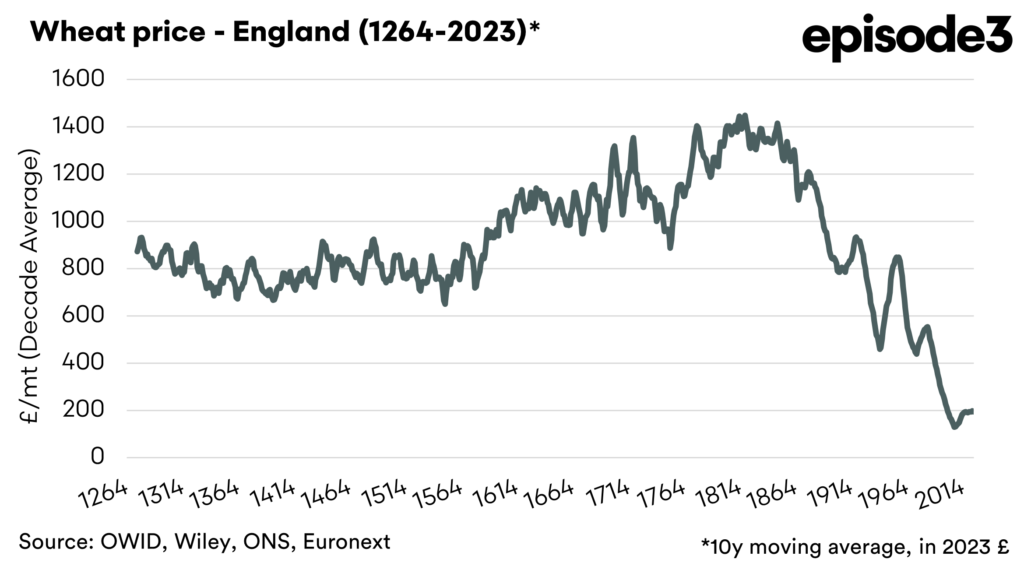Wheat prices recover from 760 year lows.

The Snapshot
- We collect as many datasets on agriculture as possible to see whether they tell a story.
- Using data makes it possible to give real validity to an argument.
- The wheat during in recent times has only just recovered from 760-year lows.
- The world has largely been keeping up with population growth, at least since the 1960s.
- Supply and demand are fundamental economic principles that farms and policymakers must understand.
- As we exceed demand, prices remain low.
- Recent moves by governments have the potential to upset the balance and cause food security issues.
The Detail
At EP3, we obviously like looking at markets and agriculture in general. People think data is just numbers, but that data can be used to tell a story.
This week, I pulled out one of my old spreadsheets, which collects the historical price of wheat, but this data is the ultra-long-term price.
This data set goes back to 1264 and displays English wheat prices. I put this up on Twitter, and it got a lot of discussion going. You can see this chart in the first chart below.
This chart considers inflation, and due to the long range, I have changed the data to a ten-year average instead of individual years.
In real terms, the wheat price has consistently fallen during the past two hundred years. This has been due to a number of factors, including the opening up of grain production in vast areas of the Americas and Australia. This added huge areas, and we have also seen technology and agronomy advances helping create bigger yields.
The corn* laws caused the peak in wheat pricing during the early 1800s. These were a series of trade laws between 1815 and 1846 which imposed restrictions and tariffs on imported grain.
Their primary purpose was to protect domestic grain producers by keeping grain prices high, especially in response to cheaper foreign imports. The laws were particularly significant during the early 19th century and had profound political and economic impacts.
Trivia – Corn*
These days, we think of corn as corn; what we typically call corn is actually maize. Traditionally, the term corn was a general term for cereal grains, and the term corn would be used in regional areas to refer to the dominant local grain crop.
In Australia, wheat is the dominant cereal and, therefore, could be called corn.
We are too good at farming.
Grain prices, when we take inflation into account, are low. We haven’t really kept up with inflation.
Farmers have been victims of our own success. Farmers love to farm; that it obvious. We love to produce big crops, who doesn’t?
Over the years, we have constantly chased big yields, and we do this by adopting technology and increasing our efficiency. This can be seen in the chart below, which shows the advancement of our yields.
Even this year, when large parts of the country have had little rain, we are still producing an above-average crop.
It’s all about supply and demand.
Supply and demand is the fundamental concept in economics. At it’s most basic, the crossover between supply and demand determines the price of a service, product or commodity.
If supply exceeds demand, then the price will fall, and vice versa.
The chart below shows the global population and wheat production/consumption. The chart is pretty simple but shows that over the course of the period 1960 to the present, we have been keeping a similar pace in our wheat production to the population.
Had farmers not improved their practices, then we would not be able to support the population we currently do.
Whilst this is good that farmers have become the great producers that they are, it has held back pricing, but on the flip side has fed the world.
The reality for every person on this planet is that without modern agricultural technology, such as chemicals and synthetic fertilizers, the price of food would be unaffordable for an 8bn population.
This is why it concerns me when I see movements such as the EU Green Deal or even RFK Jr, which look to reduce the uptake of scientific farming methods. These policies, while potentially well-meaning (or ignorant of reality) have the potential to cause huge food insecurity over the coming decades.
Anyway, it’s all food for thought isn’t it? Remember to support EP3 by subscribing here and sharing with your networks.






